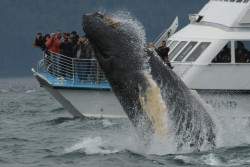Digital cameras have only recently become suitable for nature photography. Early models just took too long to respond — you would eagerly mash the shutter, but by the time the camera came to life, the subject was gone. This problem was especially severe when photographing whales, which despite their size can appear and disappear with amazing swiftness.
I cannot tell you how many times I (or my camera) have reacted too slowly for a whale. Once, years ago, I was drifting quietly near Point Adolphus in Icy Strait, a prime whale area, patiently waiting for something to happen. Then, behind me, I heard a splash and tried to turn around, bring the camera up and press the shutter button ... by which time the picturesque breaching whale was a distant memory.
I now have a Canon EOS 40D, which seems to have solved the shutter problem, indeed if you hold the shutter button down (and with the right options set) it will take a very fast series of exposures. If you have prepared yourself by acquiring a suitably large memory card, you can afford to take many more pictures than you intend to keep, an essential prerequisite for nature photography in the wild.
I have also recently figured out a few more things about whales, to augment what I learned during my around-the-world sail, where I lived among whales and dolphins a good percentage of the time. I've learned that whales are completely aware of people and what their expectations are. If a few whale-watching boats gather at Point Adolphus, you can be assured that some public-spirited whale will oblige them by leaping out of the water in the midst of the boats, in a fashion that seems calculated to maximize the cacophony of oohs and ahhs.
A little digression. How can we doubt the intelligence of whales? We spend most of our lives in little wooden boxes, vaguely reminiscent of coffins, and passively watch life unfold on glowing screens. Whales, by contrast, drift about in cold, dark water and sing mournful songs that can be heard for thousands of miles. In this comparison it doesn't require much insight to guess that we might be the stupid creatures.
Anyway. This year I set up my most agile camera with a suitably long lens and positioned myself across from another boat — not too close, far enough that the whales would feel comfortable passing between us. Which they did. A whale watching tour boat was several hundred yards away, packed with people who had no idea what to expect. I knew exactly what to expect, and I had always wanted to get a decent image of a whale breaching. For once, I was properly equipped and ready.
A pod of whales made their way between the tour boat and mine. I was ready, alert. A whale broke the surface. And ...
Notice the last picture in the above set. This is a "crop" image and represents only about 12% of the original image (the other images are also substantially cropped from the originals). It demonstrates the primary advantage in having a sensor with lots of megapixels (the Canon EOS 40D has 10.1 megapixels, by no means the largest available sensor). The primary drawback to a large sensor is that you need a lot of storage space to hold the images. The advantage is that you can crop a small part of a properly focused image and it might be usable.
I regularly take advantage of this big sensor's resolution to crop bear pictures, a technique that can make pictures seem better composed than they actually were.
Consider what this image represents. It was taken from the aft end of a small boat in rough water, with a handheld camera on a cloudy day, using a 100-400mm zoom telephoto lens (Canon EF 100-400mm f/4.5-5.6L IS USM) using image stabilization, and an ISO speed of 400 (which could contribute to image graininess). All these factors work against a usable image. But the result is perfectly usable, even when magnified as above. Believe me, this isn't because I'm some kind of photography expert — that isn't the reason. The real reason is that modern digital cameras are fantastic.


 Share This Page
Share This Page

 Share This Page
Share This Page


 Share This Page
Share This Page